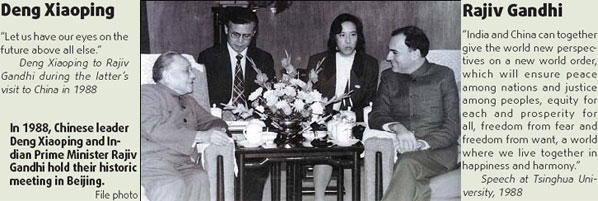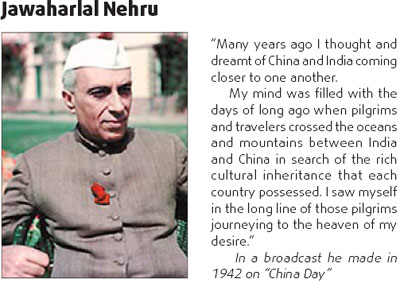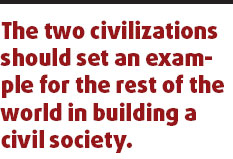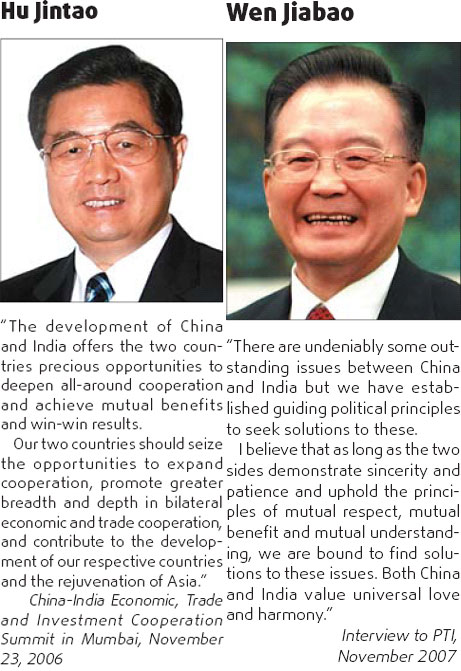Affinities that span millennia

Indian Prime Minister Manmohan Singh's visit to China marks, once again, an emotional reunion for the leaders and peoples of the two great civilizations that have had millennia of cultural affinity built upon the popularization of Buddhism in China.
Many examples illustrate this affinity. For instance, the name for China is the proud "Zhongguo", internationally known as "Middle Kingdom". A thousand years ago, it was the Chinese translation of the Sanskrit term, "Madhyadesa", which was also the proud name for Magadha, the ancient Indian state that was the heartland of Buddhism.

The Chinese have also been celebrating two lunar New Year days for more than a thousand years: the "first morning" (yuandan) and the "first night" (yuanxiao) - the first night falls 15 days after the first morning. This anomaly of two New Years is because the Buddhist calendar begins the year on a full-moon-day that is the 15th day of the Chinese lunar calendar. The yuanxiao festival's appropriation from the style of the Indian Diwali (festival of lights) further highlights Sino-Indian affinity.
In 1942, Mahatma Gandhi wrote to the Chinese government leader, "I look forward to the day when a free India and a free China will cooperate together in friendship and brotherhood for their own good and for the good of Asia and the world".
My father, Professor Tan Yun-shan (1898-1983) met Indian poet Rabindranath Tagore in Singapore in 1927, and was invited by the poet to his "Universal University" (Visva-Bharati) at Santiniketan, which he joined in 1928. He helped the poet build the "Cheena-Bhavana" (Chinese Institute) and was its Founder-Director from 1937 to 1971. He had dedicated his entire career to the promotion of Sino-Indian friendship and understanding.
While presiding over the Tan Yun-shan birth centenary celebrations on November 7, 1998, the President of India, K.R. Narayanan, said: "He is a symbol, not of a clash of civilizations, but of the coming together of two great civilizations in meaningful understanding and active cooperation."

One of my father's best friends, Professor Prabodh Chandra Bagchi (1898-1956), was the first Indian "China expert" in modern times. Bagchi was the first-ever Indian visiting professor of Peking University from 1947-49.
Plans are afoot to celebrate the 110th birth anniversary of Tan Yun-shan and Bagchi at the end of this year in Beijing and Santiniketan respectively.
Personally, I had the great honor of seeing Tagore just a few months after I was born in April 1929, and I was christened "Ashoka" by the poet.
As an example of the cultural symbiosis of two civilizations, characterized by the new English coinage "Chindia", I have "Ashoka Tan" in my heart though not on my name card.
Sino-Indian idealism
During the 1950s, Chinese and Indians had lived in the euphoria of "Hindi-Chini Bhai Bhai" (Indians and Chinese are brothers). The bilateral relationship cooled off for a couple of decades, and the two peoples have returned to a more mature and friendly mood since the historic handshake between Chinese leader Deng Xiaoping and Prime Minister Rajiv Gandhi in the Great Hall of the People in Beijing in 1988. Apart from the historical burden of boundary issues, there has been no clash of interests between China and India.
I wish to point out that China and India have much to learn from each other, especially in this day and age.
We live in a world overtaken by the tempest of globalization, a process that has made most developing nations look solely to the West for answers. This process has unfortunately thrown aside some of the very spiritual values that made our two civilizations great.
The present world has become somewhat of a labyrinth full of greed, chaos, conflict, injustice and moral degradation. It is time that we refresh our historical memories and rejuvenate the spiritual values of China and India; for example, the Sino-Indian idealism combining the Chinese "shijie datong" (harmonious world) and the Indian "vasudhaiva kutumbakam" (universal comity).
The second point I want to make is that China and India are home to 40 percent of humanity and are the world's population superpowers. What affects this mass of humanity will determine the fate of the entire world.
The rise of China and India is likened to be the emergence of the dragon and the elephant. A major theme in international studies today is: whether the dragon and elephant will quarrel or tango together?
Historically, China and India have been the richest and most developed nations of the world. They have had the experience of maintaining a mutually beneficial co-existence for 2,000 years. They are both peace-loving nations, never embarking on the course of territorial expansion and imperialist domination. They are close neighbors who both need a harmonious and quiet ambiance in their own homes and its vicinity. Their economies are mutually complementary.

There is much to gain from the dragon and elephant doing the tango. Both countries should become partners in developing into economic superpowers, as well as in promoting universal peace, harmony, prosperity and justice, as they have done in the past.
In the march to prosperity, the two civilizations should not only learn from their past cultural affinity but set an example for the rest of the world in building a civil society realizing the ideal of Chindia. Though a utopian concept, any effort in this direction will reshape the world order into a more beneficial one for all.
The author is a retired Indian professor settled in USA, former co-chairperson and now emeritus member of the Institute of Chinese Studies, Delhi.

(China Daily 01/14/2008 page15)














